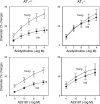Role of oxidative stress and AT1 receptors in cerebral vascular dysfunction with aging
- PMID: 19395552
- PMCID: PMC2716103
- DOI: 10.1152/ajpheart.00300.2009
Role of oxidative stress and AT1 receptors in cerebral vascular dysfunction with aging
Abstract
Vascular dysfunction occurs with aging. We hypothesized that oxidative stress and ANG II [acting via ANG II type 1 (AT(1)) receptors] promotes cerebral vascular dysfunction with aging. We studied young (5-6 mo), old (17-19 mo), and very old (23 +/- 1 mo) mice. In basilar arteries in vitro, acetylcholine (an endothelium-dependent agonist) produced dilation in young wild-type mice that was reduced by approximately 60 and 90% (P < 0.05) in old and very old mice, respectively. Similar effects were seen using A23187, a second endothelium-dependent agonist. The vascular response to acetylcholine in very old mice was almost completely restored with tempol (a scavenger of superoxide) and partly restored by PJ34, an inhibitor of poly(ADP-ribose) polymerase (PARP). We used mice deficient in Mn-SOD (Mn-SOD(+/-)) to test whether this form of SOD protected during aging but found that age-induced endothelial dysfunction was not altered by Mn-SOD deficiency. Cerebral vascular responses were similar in young mice lacking AT(1) receptors (AT(1)(-/-)) and wild-type mice. Vascular responses to acetylcholine and A23187 were reduced by approximately 50% in old wild-type mice (P < 0.05) but were normal in old AT(1)-deficient mice. Thus, aging produces marked endothelial dysfunction in the cerebral artery that is mediated by ROS, may involve the activation of PARP, but was not enhanced by Mn-SOD deficiency. Our findings suggest a novel and fundamental role for ANG II and AT(1) receptors in age-induced vascular dysfunction.
Figures




References
-
- Andresen JJ, Faraci FM, Heistad DD. Vascular responses in Mn-SOD-deficient mice. Am J Physiol Heart Circ Physiol 287: H1141–H1148, 2004. - PubMed
-
- Basso N, Cini Pietrelli A R, Ferder L, Terragno NA, Inserra F. Protective effect of long-term angiotensin II inhibition. Am J Physiol Heart Circ Physiol 293: H1351–H1358, 2007. - PubMed
-
- Brown KA, Didion SP, Andresen JJ, Faraci FM. Effect of aging, MnSOD deficiency, and genetic background on endothelial function: evidence for MnSOD haploinsufficiency. Arterioscler Thromb Vasc Biol 27: 1941–1946, 2007. - PubMed
Publication types
MeSH terms
Substances
Grants and funding
LinkOut - more resources
Full Text Sources
Medical
Molecular Biology Databases
Research Materials
Miscellaneous

